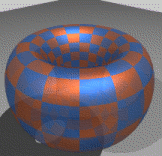



Welcome to the home of Ernie Hamblin's Guitar World. Here you will find all things guitar and recording. Listed on this page will be the tools I use to shape the sound of the final recorded product. I spend anywhere from 5-20 hours a week working on music so I needed some tools of the trade to get the sound I wanted to achieve. Over the years, I've owned about 50 guitars. Everything from Jackson, Charvel, Gibson, Fender, Paul Reed Smith, and almost any manufacturer you can come up with, I've probably owned one. Here's the rundown of what is currently in the arsenal.
 2009
Ibanez JS-20 - This thing is a beast. Very slim curved profile body
and tons of features. This model sports dual humbucking pickups with coil
tapping. The locking tremolo system is hands down the best I've ever
played for staying in tune and versatility. The slim neck allows for easy
access to highs and the rosewood neck fingerboard is flawless. Equipped
with the 20th anniversary version of Joe Satriani Silver Surfer design and
matching headstock graphic. This is one of Ibanez best production
guitars.
2009
Ibanez JS-20 - This thing is a beast. Very slim curved profile body
and tons of features. This model sports dual humbucking pickups with coil
tapping. The locking tremolo system is hands down the best I've ever
played for staying in tune and versatility. The slim neck allows for easy
access to highs and the rosewood neck fingerboard is flawless. Equipped
with the 20th anniversary version of Joe Satriani Silver Surfer design and
matching headstock graphic. This is one of Ibanez best production
guitars.
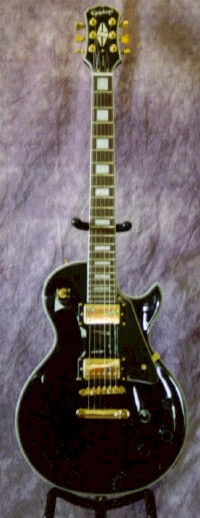
2001 Epiphone Les Paul Custom - Sometimes not spending $2,000 on a custom shop guitar has it's advantages. This beauty serves as my main guitar if for no other reason than its versatility. With this I can smoothly transition from playing Aerosmith to Boston to just about any classic rock one can think of just by changing a few presets on the guitar processor. I put light strings on it (high E string is .009 mm) for ease of playing and it still puts out a booming sound. It has a deep, thick, full tone without the $2,000 price tag of a Gibson version of the same animal. I recently played a 1959 Gibson Les Paul and if I closed my eyes for a few seconds, I couldn't tell the difference in sound between this one and the 1959 which was listing for a whopping $10,900. The set in neck is stable as a rock, the pickups are warm and clean. The action is one of the lowest I've seen and I've never had to tinker with it since the day I bought it. It has the classic Gibson Les Paul "C" shaped bound neck and due to the finish it's as fast as any I've ever played. With such a wide variety of tones and sound shapes to choose from, it's the one guitar in my collection I consider absolutely indispensable and comes with my highest recommendation.
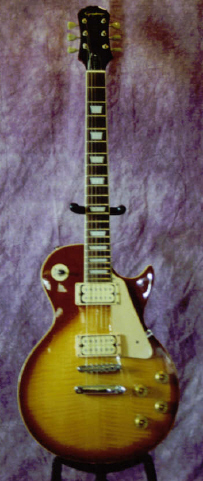
1978 Epiphone Les Paul - This is an older (more mature) version of the guitar pictured above. It really does all of the same things as the other Les, but has a slightly different look and tonal quality. This guitar is equipped with DiMarzio pickups which tend to sound a little sharper in tone than the 2001 Custom model. The pickups are so sensitive they sometimes capture sounds in the room, so I have to be careful if I'm not recording directly to digital recorder not to pick up things like TV. This can usually be filtered out with the noise gate on the GNX 3. Despite its age, this guitar is actually set up well to cover some of the newer bands like Fuel that use the Les Paul as a building block for their sound. The only thing I find strange about this particular guitar is the tuning machines. They are an opaque olive in color which doesn't come close to the guitar's color scheme. I was at a guitar expo in Fort Washington, PA a few years back and saw this in a dealer's stock. Some bartering later, I ended up trading a Peavey Bass and Steinberger guitar for it. While in list price I probably gave up too much to get it, this served as my main recording axe until I purchased the 2001 model when Zapf's music was going out of business. With all the music I was able to get out of it, I still find it to be a good deal.
 1978 Fender Stratocaster - Every rock
guitarist in history either has owned or should own one of these. Eric
Clapton, David Gilmour, and Ritchie Blackmore are among the players who swear by
the Fender brand. After playing it for half a year, I can certainly see
why these outstanding players find the Fender Strat so compelling. This one has a swamp ash body and bolt on Canadian curly
maple neck making it light and sturdy. After playing a Les Paul, this is
like playing a feather with a full five pound weight difference between the
two. I made a few setup changes on it to
lower the action since I originally purchased it used in 2003, but other than
that I've only needed to change the strings. I put Nanoweb strings on it
and I'm very pleased with the classic rock sound I get out of it. I can get the full range from
blues, to classic rock, to hard rock with a few flips of the five position tone
switch. My original knock on Fender guitars was that my playing style
knocked them out of tune too easily. The Sperzel locking tuners on this
took care of my only gripe. It has a tremolo bridge, but I took the arm
off since I don't rely on them much to add flavor to my playing. With its lightness in proportion to its size,
it's the most comfortable guitar I own to play.
1978 Fender Stratocaster - Every rock
guitarist in history either has owned or should own one of these. Eric
Clapton, David Gilmour, and Ritchie Blackmore are among the players who swear by
the Fender brand. After playing it for half a year, I can certainly see
why these outstanding players find the Fender Strat so compelling. This one has a swamp ash body and bolt on Canadian curly
maple neck making it light and sturdy. After playing a Les Paul, this is
like playing a feather with a full five pound weight difference between the
two. I made a few setup changes on it to
lower the action since I originally purchased it used in 2003, but other than
that I've only needed to change the strings. I put Nanoweb strings on it
and I'm very pleased with the classic rock sound I get out of it. I can get the full range from
blues, to classic rock, to hard rock with a few flips of the five position tone
switch. My original knock on Fender guitars was that my playing style
knocked them out of tune too easily. The Sperzel locking tuners on this
took care of my only gripe. It has a tremolo bridge, but I took the arm
off since I don't rely on them much to add flavor to my playing. With its lightness in proportion to its size,
it's the most comfortable guitar I own to play.
 2007
Fender Stratocaster - Like the one above, this is another
versatile rock instrument from Fender. The sound has a slightly different
shape with more midrange than the other Strat listed above. It has a
smooth vintage style v-shaped neck, vintage gold tuners and gold tremolo arm
(not pictured). The guitar was made to specs of the original to
commemorate Leo Fender's 50th anniversary of starting the company. As you
can see when looking at both pictures simultaneously, the headstock is 1950's
model and considerably smaller than the one made in the 1970's. This
guitar serves well for replicating vintage 60's and 70's guitar sounds along the
lines of Jimi Hendrix, Eric Clapton and their guitar contemporaries. The
sound is can range from silky smooth to a very crisp bite with a lot of
clarity.
2007
Fender Stratocaster - Like the one above, this is another
versatile rock instrument from Fender. The sound has a slightly different
shape with more midrange than the other Strat listed above. It has a
smooth vintage style v-shaped neck, vintage gold tuners and gold tremolo arm
(not pictured). The guitar was made to specs of the original to
commemorate Leo Fender's 50th anniversary of starting the company. As you
can see when looking at both pictures simultaneously, the headstock is 1950's
model and considerably smaller than the one made in the 1970's. This
guitar serves well for replicating vintage 60's and 70's guitar sounds along the
lines of Jimi Hendrix, Eric Clapton and their guitar contemporaries. The
sound is can range from silky smooth to a very crisp bite with a lot of
clarity.
2003
Ibanez Artcore - One of the sounds almost impossible to accurately replicate
with a solid body guitar is the sound of a hollow bodied guitar. To get
around that I picked up this guitar and it has worked out just nicely. The
body of the guitar is considerably larger than any of the solid bodied guitars I
own so it took some getting used to. The sound from the dual humbucking
pickups can range from the biting lead style to a soft smooth jazz sound.
Because of the way the pickups are mounted, sound resonates from the strings in
front and the body in back to the pickups creating a huge sound. Depending
on the reverb setting on the amp and PA system, you can get a great arena rock
sound out of this guitar.
2004
OLP (Ernie Ball Copy) - This is a copy of the Van Halen Era Ernie Ball
guitars that Eddie Van Halen lent his licensure to during the late 80's and
early 90's. I picked it up online for a hundred bucks figuring I could
live with the color and worst case I could set it up as a teaching guitar for my
daughter. When I got it out of the box I was pleasantly surprised how well
it was constructed. After I plugged it in I was sold. Many knockoffs
and copies of name brand guitars tend to have subpar materials and shoddy
workmanship, but I'm actually impressed with this one. There was no fret
buzz out of the box and the action was set up very well from the factory.
Within two minutes it was tuned up and ready to go. The neck is straight
and solid and it's minimalist design fits it's purpose perfectly. If I
want to do any material from the Sammy Hagar Van Halen Era, this is the axe of
choice.
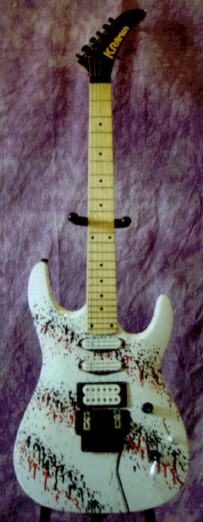 1984 Kramer Striker Custom Shop - There's
a great, but sad story behind this guitar. I purchased this from a
merchant on EBay who related the story to me. This guitar body was
originally brought in to a NY luthier to have a new neck put on and electronics put
into it in late summer of 2001. As it turns out, the original owner who
ordered the customization was killed in the 9/11 terrorist attack at the World
Trade Center. The
family didn't wish to have it back and I was the bidder who ended up picking it up on
EBay when it went up for sale by the luthier who did the customization. Due to it's history, I
won't change a thing on it, keeping it in the exact setup as its original owner
out of respect. It has a pair of Seymour Duncan quad-rail pickups in the neck and middle
positions and a Seymour Duncan humbucker in the bridge. It sounds every
bit like Eddie Van Halen's guitar for the first 10 or so years of his career and
I use it mainly for that purpose. With its history, I affectionately refer
to this guitar as "911" and I hope if I ever sell it that it will go
to someone who can appreciate the personal history behind it.
1984 Kramer Striker Custom Shop - There's
a great, but sad story behind this guitar. I purchased this from a
merchant on EBay who related the story to me. This guitar body was
originally brought in to a NY luthier to have a new neck put on and electronics put
into it in late summer of 2001. As it turns out, the original owner who
ordered the customization was killed in the 9/11 terrorist attack at the World
Trade Center. The
family didn't wish to have it back and I was the bidder who ended up picking it up on
EBay when it went up for sale by the luthier who did the customization. Due to it's history, I
won't change a thing on it, keeping it in the exact setup as its original owner
out of respect. It has a pair of Seymour Duncan quad-rail pickups in the neck and middle
positions and a Seymour Duncan humbucker in the bridge. It sounds every
bit like Eddie Van Halen's guitar for the first 10 or so years of his career and
I use it mainly for that purpose. With its history, I affectionately refer
to this guitar as "911" and I hope if I ever sell it that it will go
to someone who can appreciate the personal history behind it.
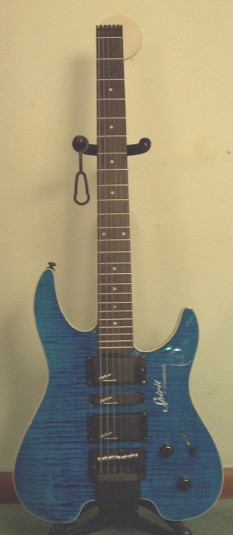 1999
Steinberger Spirit - I originally purchased this guitar with the thought of
using it as purely a travel guitar due to it's compact size. While that is
a tremendous feature, it also has 24 easily accessible frets and EMG Select
pickups in all three positions. You could slam this against a wall and it
ill not go out of tune, making it a perfect guitar for practice and recording
alike. It's a bit like a hybrid between a Les Paul and a Fender Strat
giving it a flavor all it's own. The body style it like a Strat, but the
pickups are warm and smooth like the Les Paul. This is also the only
guitar I own that has an oiled maple neck. It was strange at first,
especially when you consider it has no headstock, but once I got used to it the
transition was fine. It's still a little wild when I go from something
like a Fender Strat that has a huge headstock to none at all. Changing
strings is a little weird as well since the strings are a set length and lip
into slots at the top of the neck and bottom of the bridge. There are a lot of
applications for it and as it turns out, I've used it for more recording than as
a travel guitar. Don't let the compact size fool you, it does have some
weight to it. Most of the weight is in the ass end where the tremolo
bridge and
tuners are. Despite that it is a very comfortable and pleasing guitar to
play.
1999
Steinberger Spirit - I originally purchased this guitar with the thought of
using it as purely a travel guitar due to it's compact size. While that is
a tremendous feature, it also has 24 easily accessible frets and EMG Select
pickups in all three positions. You could slam this against a wall and it
ill not go out of tune, making it a perfect guitar for practice and recording
alike. It's a bit like a hybrid between a Les Paul and a Fender Strat
giving it a flavor all it's own. The body style it like a Strat, but the
pickups are warm and smooth like the Les Paul. This is also the only
guitar I own that has an oiled maple neck. It was strange at first,
especially when you consider it has no headstock, but once I got used to it the
transition was fine. It's still a little wild when I go from something
like a Fender Strat that has a huge headstock to none at all. Changing
strings is a little weird as well since the strings are a set length and lip
into slots at the top of the neck and bottom of the bridge. There are a lot of
applications for it and as it turns out, I've used it for more recording than as
a travel guitar. Don't let the compact size fool you, it does have some
weight to it. Most of the weight is in the ass end where the tremolo
bridge and
tuners are. Despite that it is a very comfortable and pleasing guitar to
play.
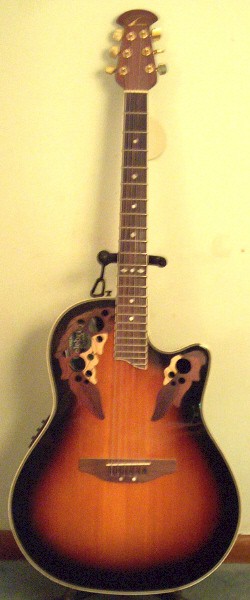 1986
Ovation Celebrity Acoustic - Back in 1990, I purchased this guitar from a
Cherry Hill, NJ music store because I needed an acoustic I could record
with. This one more than fits the bill for my needs. It has a
beautiful, rich sound both acoustically and through and amp. It has a full
rounded back which you can't pick up from the picture and sound resonates
through the body well, giving it sustain like an electric guitar. It has
three tone adjustment sliders on the side of the body which control the pickup
in located just inside the back of the body. One of the stranger features
is the presence of a 9 volt battery compartment in the back of the body that
powers the on board equalizer. There is a circular cutout in the back that
is held in by a single screw and when you loosen it the cutout comes off with
the battery compartment attached directly to it. Unlike many acoustics I've
played, the neck is quite slim and allows for easy and effortless access to the
frets even on the high end. If I had it to do over again, I'd get a slimmer bodied model for
sit down playing comfort, but I'm so used to this one, I don't see myself
getting rid of it any time soon.
1986
Ovation Celebrity Acoustic - Back in 1990, I purchased this guitar from a
Cherry Hill, NJ music store because I needed an acoustic I could record
with. This one more than fits the bill for my needs. It has a
beautiful, rich sound both acoustically and through and amp. It has a full
rounded back which you can't pick up from the picture and sound resonates
through the body well, giving it sustain like an electric guitar. It has
three tone adjustment sliders on the side of the body which control the pickup
in located just inside the back of the body. One of the stranger features
is the presence of a 9 volt battery compartment in the back of the body that
powers the on board equalizer. There is a circular cutout in the back that
is held in by a single screw and when you loosen it the cutout comes off with
the battery compartment attached directly to it. Unlike many acoustics I've
played, the neck is quite slim and allows for easy and effortless access to the
frets even on the high end. If I had it to do over again, I'd get a slimmer bodied model for
sit down playing comfort, but I'm so used to this one, I don't see myself
getting rid of it any time soon.
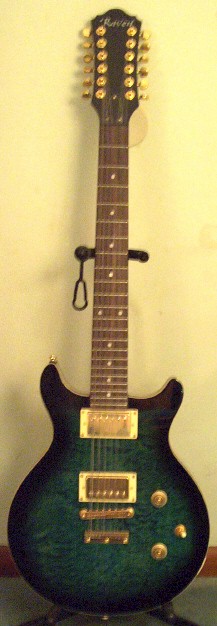 2001
Raven 12 String Electric - There are certain applications where you just
need a 12-string guitar, the sound cannot be replicated any other way.
Since it's a single purpose guitar, I didn't want to break the bank and found
this one on EBay in the neighborhood of $300. It has a very smooth sound
characteristic of just about every 12 string guitar. It's like adding
chorus to the sound without adding artificial chorus through a guitar
processor. While it is an electric guitar it shares many of the same
flavors as an acoustic guitar. It has a wide, flat neck and a chambered
body making it one of the lightest bodied guitars that I own. It is slightly
awkward to get used to since much of the weight is in the neck and head
stock. It's definitely worth the trade off though since it is able to
produce a very unique sound that I can't get in any other way. I wouldn't
recommend using it with any kind of distortion though, it's just not made for
that purpose. There is one part of it that I don't care for and that is
the body finish. The front of the body has what appears at first to be a
thin veneer of curly maple. At closer glance, it is actually done with a
process developed in the 90's where a photo print of curly maple is placed over
the body wood and stained to look like curly maple. Maybe I'm picky, but
it is something I'd consider if I was to buy another one. No gripes in the
sound department though and that's what a guitar is used for anyway.
2001
Raven 12 String Electric - There are certain applications where you just
need a 12-string guitar, the sound cannot be replicated any other way.
Since it's a single purpose guitar, I didn't want to break the bank and found
this one on EBay in the neighborhood of $300. It has a very smooth sound
characteristic of just about every 12 string guitar. It's like adding
chorus to the sound without adding artificial chorus through a guitar
processor. While it is an electric guitar it shares many of the same
flavors as an acoustic guitar. It has a wide, flat neck and a chambered
body making it one of the lightest bodied guitars that I own. It is slightly
awkward to get used to since much of the weight is in the neck and head
stock. It's definitely worth the trade off though since it is able to
produce a very unique sound that I can't get in any other way. I wouldn't
recommend using it with any kind of distortion though, it's just not made for
that purpose. There is one part of it that I don't care for and that is
the body finish. The front of the body has what appears at first to be a
thin veneer of curly maple. At closer glance, it is actually done with a
process developed in the 90's where a photo print of curly maple is placed over
the body wood and stained to look like curly maple. Maybe I'm picky, but
it is something I'd consider if I was to buy another one. No gripes in the
sound department though and that's what a guitar is used for anyway.
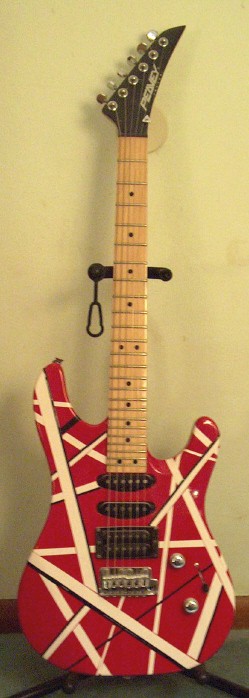 1988
Peavey Tracer - This guitar has been in my collection longer than any
other I currently own. As you can tell by the "1984" Van Halen
style paint job, this one has been with me since the late 1980's. This
goes back to the days when all I played was metal and this guitar certainly fit
the bill for that purpose. It has a very sharp, almost tinny quality to
the tone and sounds like most of the guitars you'll hear in 1980's heavy
metal. Great for doing Judas Priest, Dokken, and of course Van Halen (as
the paint job suggests). It originally came as solid red, but I put on the
stripes after market several years ago when everyone was making Van Halen knock
off guitars. It's clearly not the same type of guitar as easily spotted by
the head stock and neck. The original EVH guitars were Kramers, not
Peaveys, and featured what is known as a "banana headstock". I don't play this one all that often anymore
since my musical tastes have matured to a different style, but I couldn't bear
to part with it since it dates back to the days when I was single. This is
another one of my guitars that I don't use the tremolo arm with even though the
bridge is equipped for it. With no locking nut, it tended to go out of
tune easily, something that was rectified easily by removing the tremolo
arm. When
and if my daughter decides to take up the instrument, this will be the one I
give her since it has taken a beating over the years and is none the worse for
wear. It has a slim tapered neck that is perfect to learn on, or if you
have small hands.
1988
Peavey Tracer - This guitar has been in my collection longer than any
other I currently own. As you can tell by the "1984" Van Halen
style paint job, this one has been with me since the late 1980's. This
goes back to the days when all I played was metal and this guitar certainly fit
the bill for that purpose. It has a very sharp, almost tinny quality to
the tone and sounds like most of the guitars you'll hear in 1980's heavy
metal. Great for doing Judas Priest, Dokken, and of course Van Halen (as
the paint job suggests). It originally came as solid red, but I put on the
stripes after market several years ago when everyone was making Van Halen knock
off guitars. It's clearly not the same type of guitar as easily spotted by
the head stock and neck. The original EVH guitars were Kramers, not
Peaveys, and featured what is known as a "banana headstock". I don't play this one all that often anymore
since my musical tastes have matured to a different style, but I couldn't bear
to part with it since it dates back to the days when I was single. This is
another one of my guitars that I don't use the tremolo arm with even though the
bridge is equipped for it. With no locking nut, it tended to go out of
tune easily, something that was rectified easily by removing the tremolo
arm. When
and if my daughter decides to take up the instrument, this will be the one I
give her since it has taken a beating over the years and is none the worse for
wear. It has a slim tapered neck that is perfect to learn on, or if you
have small hands.
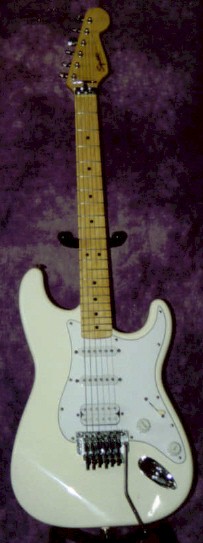 1995
Squier Stratocaster - The cheaper of the Fender line, I bought this back
when Zapf's music on 5th street in Philadelphia was closing out stock for
$200. Zapf's first closed their Philadelphia 5th street location and then
a year later, closed their Pennsauken, NJ location to go into the online
market. They are now able to be found at Music123.com and have a ton of
reasonably priced inventory. At the time I bought this, I didn't have a Fender product and wanted to expand my
playing style. It looks and plays much like Ritchie Blackmore's
Stratocaster, except for the humbucking pickup in the bridge position.
This one is significantly heavier than the top end Fender I own, making it
pretty close to the Les Pauls in weight. One
can pretty easily replicate a 70's deep style tone just by plugging it straight
into a Marshall amp with no guitar processor. Until I picked up a real
Fender Stratocaster in 2003, it was my main device for replicating Eric Clapton,
Deep Purple, and Pink Floyd types of songs. I could get close to those
sounds, but with a humbucking pickup in the bridge position, it sounded a great
deal like a Les Paul with a Fender Strat neck on it. With the introduction into the
collection of the "real deal", I mainly use this a backup when
recording. Despite the low price tag, it's still a blast to play. I
tend to use it now for heavier applications requiring s strat like Queensryche,
Iron Maiden, and songs with a distorted heavy strat sound. I'm eventually
going to do some graphics on the body but I haven't settled on exactly what that
would be yet.
1995
Squier Stratocaster - The cheaper of the Fender line, I bought this back
when Zapf's music on 5th street in Philadelphia was closing out stock for
$200. Zapf's first closed their Philadelphia 5th street location and then
a year later, closed their Pennsauken, NJ location to go into the online
market. They are now able to be found at Music123.com and have a ton of
reasonably priced inventory. At the time I bought this, I didn't have a Fender product and wanted to expand my
playing style. It looks and plays much like Ritchie Blackmore's
Stratocaster, except for the humbucking pickup in the bridge position.
This one is significantly heavier than the top end Fender I own, making it
pretty close to the Les Pauls in weight. One
can pretty easily replicate a 70's deep style tone just by plugging it straight
into a Marshall amp with no guitar processor. Until I picked up a real
Fender Stratocaster in 2003, it was my main device for replicating Eric Clapton,
Deep Purple, and Pink Floyd types of songs. I could get close to those
sounds, but with a humbucking pickup in the bridge position, it sounded a great
deal like a Les Paul with a Fender Strat neck on it. With the introduction into the
collection of the "real deal", I mainly use this a backup when
recording. Despite the low price tag, it's still a blast to play. I
tend to use it now for heavier applications requiring s strat like Queensryche,
Iron Maiden, and songs with a distorted heavy strat sound. I'm eventually
going to do some graphics on the body but I haven't settled on exactly what that
would be yet.
2004
Galveston Triple Neck - Affectionately known as "The
Monster" this guitar combines a Stratocaster style body with 6, 7, and 12
string necks. This is not for the faint of heart weighing in at over 25
lbs. It's also one of the more versatile guitars you'll find. You
can activate one, two, or all three necks simultaneously to create a huge 25
string sound. You can play a rhythm piece on the top 12 string neck and
solo over it with the other two. One of the nicer aesthetic features is a
root beer colored curly maple top which no picture can accurately seem to
capture. The six humbucking pickups on this giant produce a sound range
from a chorusy 12 string to the gritty, dirty sound of a low tuned 7-string
guitar. Since there aren't many triple neck guitars in production, this
one is sure to hold it's value.
Digitech GNX 3 Guitar Processor - Nothing I know of on the market under $1,000 changes the shape of sound quite like the GNX 3. It can be used as an 8 track digital recorder, a signal processor, guitar tuner, amp modeler, almost anything you'd buy a separate pedal for is all rolled into one on this unit. I really use it for two purposes, recording and changing the shape of the sound that each of the above guitars makes. In order to do this, I'll start with a clean sound and then add one piece at a time until I've "built" the sound I'm looking for. Once this is done, I can then save it on one of the 65 memory banks and call it up when I need it with just the touch of a pedal. For songs that require more than one type of sound, I'll put the two or three that I'll need next to one another in memory so I can switch from one to the other with just a tap of a pedal. Recording is basically done the same way. I can use the tap pedals to start, stop, and pause the recording process. It also has a built in drum machine that helps with maintaining the rhythm of the song during recording. It's probably the one piece of equipment that makes the most difference in the quality of sound and recording I'm able to produce.
Marshall 12-Watt Stack Amp - Once the sound goes from the guitar through the GNX 3, it has to have a way to get to the outside world and this is its primary mode of transportation. At first glance you'd think, "Aw what a cute little thing", but this amp is so much louder than it looks. This is also the same amp that Kurt Cobain used in studio to record much of Nirvana's early material. The Marshall head pushes the sound out through two 10 inch Celestian speakers providing quite a thump. Despite the 10 inch speakers, it's able to accurately convey the bass end of the sound, which is unusual out of a relatively small amp. Since the sound is already shaped just the way I want it before it gets to the amp, all I really use the amp to do is make it louder. I've used Marshall amps for the last 15 years and I swear by their reliability and ability to keep the guitar signal exactly as I sent it there. I've used other brands such as Crate and Fender, but each of those tend to change the sound I'm putting into them. This is actually a step back from the amp I used to have, the 100 watt version of the same thing. I found that to be too much amp for what I needed. It was hard as hell to store or transport, and the the eight ten inch speakers shook the walls and windows on volume setting two. I had to go smaller to avoid frequent complaints from the neighbors and visits from the local police. Since most of the recording I do directly into a digital recorder, I really have no need for anything bigger at this point. This is mainly for playing live and the sound quality is top notch as I've come to expect from Marshall products. I have miked this amp for recording purposes, but the mike was sometimes too sensitive and ended up picking up outside sound due to where I was doing the recording. For my purposes, playing live, this is exactly what I need.
Korg Triton LE 61 Key Workstation - Once the guitars and bass are recorded, the next step for me is to add depth to the "wall of sound." Many of the bands I've listened to over the years favor the same approach and add keyboard as essentially a filler instead of a lead instrument. I got more than I even expected from this unit. It has over 500 preset sounds, drum kits, a built in sequencer, and the ability to record to 16 tracks of digital audio with a port for a memory card. It could be expanded to accommodate a sampling card, but I have no need for that at the moment. With this unit I can add everything from piano, strings, sound effects, to explosively huge classic keyboards. The synthesizers are very true sounding, the controls are easy to work with even if the manual is three quarters of an inch thick. I never really sat down with the manual to pour over all the things it can do, but for my purposes I really don't need to. Every once in a while, I'll find a preset or component that I learn to use and I'll add that to the arsenal of what I can do. Since I'm primarily a guitar player and I'm only using keyboards to make the recorded sound fuller this is another piece that is exactly what I need for right now. I wasn't going to pay an extra $1,000 for weighted keys and a touch screen, so the $1,299 I paid for this was plenty enough to fit the bill.
Links: